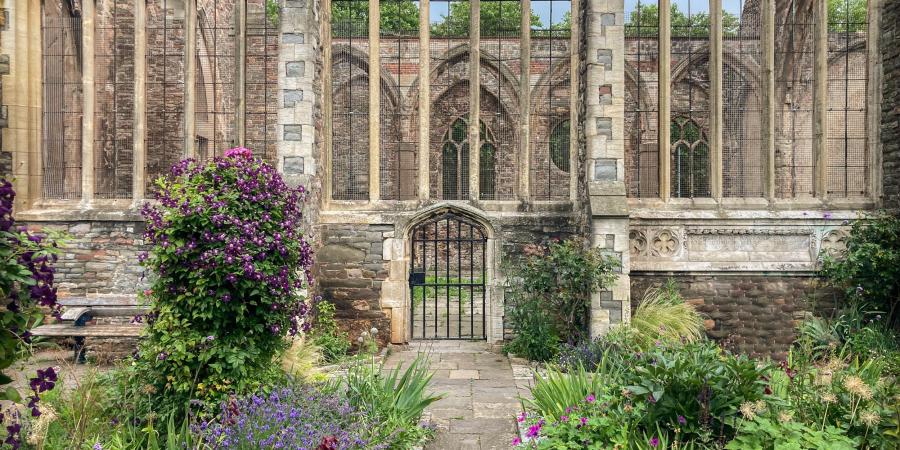St Peter’s is a ruined church in the middle of Castle Park, Bristol. Today this park is a leafy riverside oasis, but its modern appearance belies its true origins: this was once a densely built-up commercial district in the oldest part of Bristol. In November 1940 Bristol was heavily bombed, leaving most of the central area in ruins. St Peter’s Church was gutted by fire, but its scorched walls remained standing. After the War, St Peter’s, along with nearby St Mary-le-Port and Temple Church were preserved as ruins, and St Peter’s was designated as a memorial to the victims of the Bristol Blitz.
Above: St Peter's Church, looking north-east
Maintaining buildings as standing ruins is a tricky business: they were designed to be roofed. Without this protection, exposed masonry is vulnerable to weathering, ingress by rain, frost, and plants roots. In recent years, the stonework of St Peter’s had become increasing precarious and consequently the building was closed to the public and placed on Historic England’s Buildings at Risk Register. Fortunately, Bristol City Council was able to secure funding from Historic England to repair the walls and has now started the process of bringing the building back into public use. One major hurdle remains: the floor, which is a 1970s construction of concrete and gravel, is in poor condition, and in places is significantly subsiding. Before a new floor can be designed, we need to know why this is happening. To find this out, Wessex Archaeology has been commissioned to carry out a ground penetrating radar survey, followed by the hand excavation of test pits to test the results of the survey. As well as providing essential structural information, it is hoped that this work may shed some light on the development of the church.
The excavations took part in July 2022. As the excavations coincided with national Festival of Archaeology, a public viewing area was provided at the west end of the church, with an archaeologists on hand to discuss the history of the building and how the investigations were progressing. An open day was also held on site, with artefact handling and other activities.
Anglo-Saxon and Norman origins
St Peter’s is probably Bristol’s oldest church, and it is almost certainly built on the site of an earlier Anglo-Saxon place of worship.
Bristol originated as a late Anglo-Saxon ‘burg’ - a fortified settlement - named Brycgstow, meaning ‘place of the bridge’, which was probably established in the 9th century AD. By the early 11th century, Brycgstow had become an important trading centre, which contained a mint producing silver pennies stamped with its name. Brycgstow occupied a naturally defensible position on a low promontory, surrounded on three sides by the rivers Frome and Avon and extensive areas of marshland. These natural defences were probably supplemented by a substantial ditch and timber palisade, which surrounded what is now the Old City and the west end of Castle Park. St Peter’s was situated immediately to the east (outside) of Brycgstow’s defensive ditch, and probably served as the parish church for the adjacent royal Manor of Barton.
After the Norman Conquest (AD 1066), a timber motte-and-bailey castle was built at the east end of what is now Castle Park, and the town’s defences were extended to encompass the area around St Peter’s Church.
The earliest reference to St Peter’s dates from AD 1106, when control of the church was granted to Tewkesbury Abbey. The 12th century was a time of huge change in Bristol: the timber castle was replaced by a massive rectangular stone keep, surrounded by high walls, towers, and deep rock-cut moats, and new monasteries began to spring up around the rapidly expanding town. The earliest surviving part of St Peter’s – the lower stages of the tower – probably date from the 12th century, or possibly a little earlier.
Medieval growth and prosperity
By the medieval period, Bristol had become England’s second largest seaport, which had a busy maritime trade with Ireland, France, Spain, and Portugal. To facilitate this trade, the River Frome was diverted to form a new deep water berthing, and the town’s defences were expanded to encompass the growing suburbs of Redcliffe, Old Market, and Broadmead. By this date, the old town centre had become densely built up. St Peter’s and its small churchyard fronted onto Peter Street, one of the town’s main east-west roads; the other sides of the churchyard were surrounded by stone and timber-framed buildings.
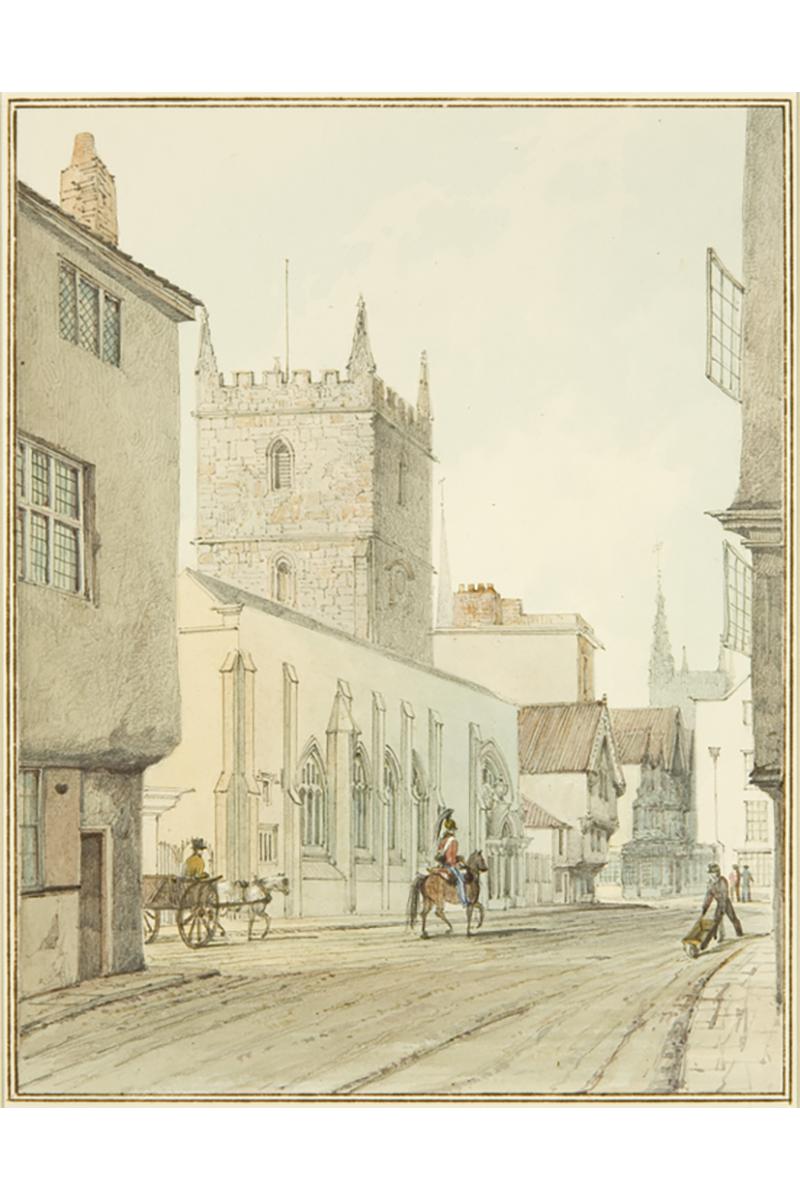
Above: St Peter's Church from the north-east, by T. L. Rowbotham, 1828. Reproduced with permission of Bristol Museum and Art Gallery (ref. M2666)
During the later medieval period, Bristol became increasing prosperous, and many of its churches, including St Peter’s were rebuilt or extended. Apart from the tower, most of the surviving parts of St Peter’s probably date from c. 1380–1415 and are built in the Perpendicular Gothic style of the period. The late medieval parts of the church comprise an uncelestoried nave and chancel, with north and south aisles. The cramped city-centre location restricted the width of the north aisle, which is much narrower than the south aisle. The medieval church contained at least three chapel, two to St Mary and one to St Catherine; a piscina, used to dispose of used sacramental water; and an early 15th-century cadaver tomb to a member of the Norton family of merchants, who lived in the Great House, immediately to the south of the church.
Bristol and St Peter’s in the post-medieval period
The history of post-medieval Bristol is inextricably linked to that of the European colonisation of the Americas. Beginning with the rediscovery of Newfoundland by the Italian explorer Giovanni Caboto (known in England as John Cabot) in 1497, Bristol merchants would go on to play a leading role in the colonisation of the West Indies and Virginia, the development of the sugar and tobacco trade, and, from the 1670s onwards, the transatlantic slave trade.
Profits from the Atlantic trade flowed back to Bristol and many local merchants became extremely wealthy. One such individual was Alderman Robert Aldworth, who was buried in St Peter’s Church in 1634. Aldworth was a former mayor of Bristol, who established the city’s first sugar house in 1612 in a building next to the Norton’s Great House, which Aldworth rebuilt as a timber-framed mansion. The sugar that Aldworth processed was produced by enslaved Africans working on Spanish and Portuguese plantations in Madeira, Brazil, and the Azores. His sugar house was later run by the slave trader and merchant Edward Colston. The Great House was subsequently converted into a mint, and in 1696 it became a workhouse known as St Peter’s Hospital. After Aldworth’s death, his family erected a large and ornate memorial in the south aisle of St Peter’s, the base of which had carved panels depicting ships, his monograph, and images of barrels and sugar loaves: symbols of his trade. There was a second large and ornate early 17th-century memorial, purportedly to Lady Antholin Newton, next to the Aldworth memorial.
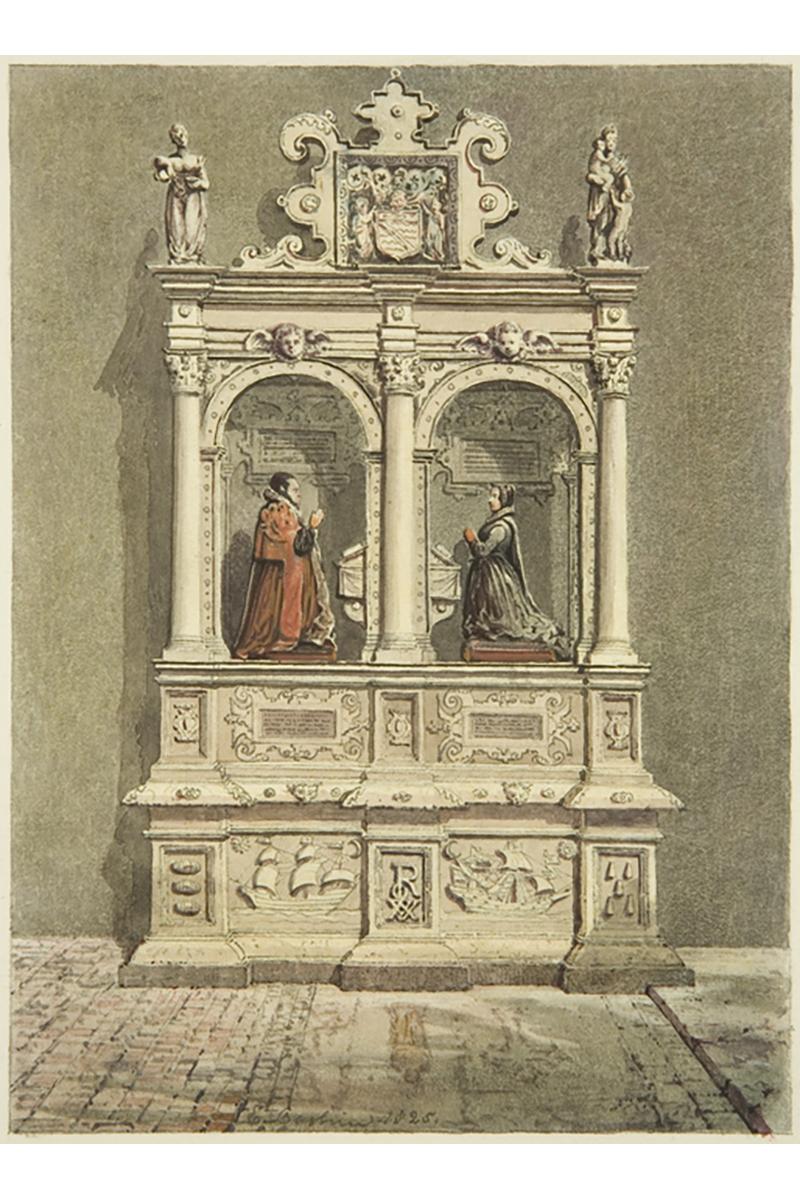
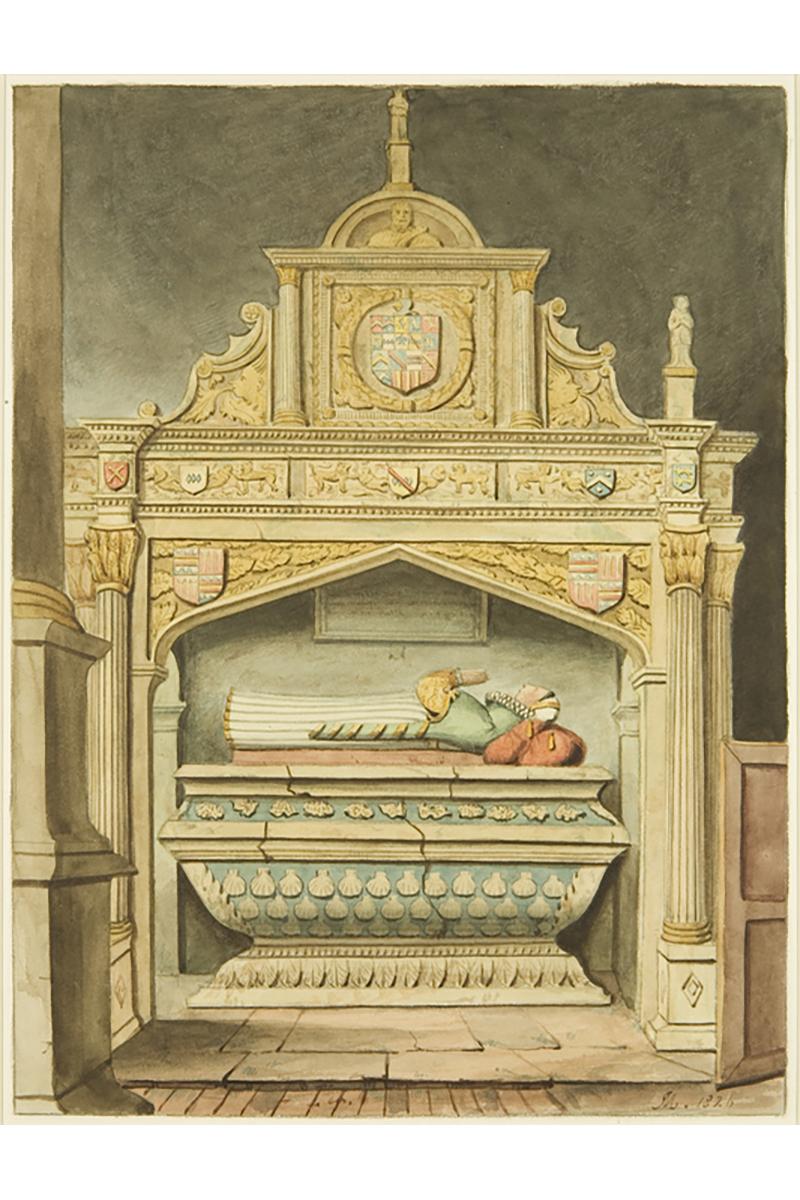
Left: Memorial to Robert and Martha Aldworth, by E. Cashin, Reproduced with permission of Bristol Museum and Art Gallery (ref. M2667)
Right: Memorial to Antholin Newton, by J. Manning, Reproduced with permission of Bristol Museum and Art Gallery (ref. M2675)
Later modifications to the church include the addition of battlements to the tower in 1657; box pews and an ornate oak reredos (ornamental screen) behind the altar in the 1690s; a Gothic choir screen in 1912; and a subterranean boiler room in the late 19th or early 20th century.
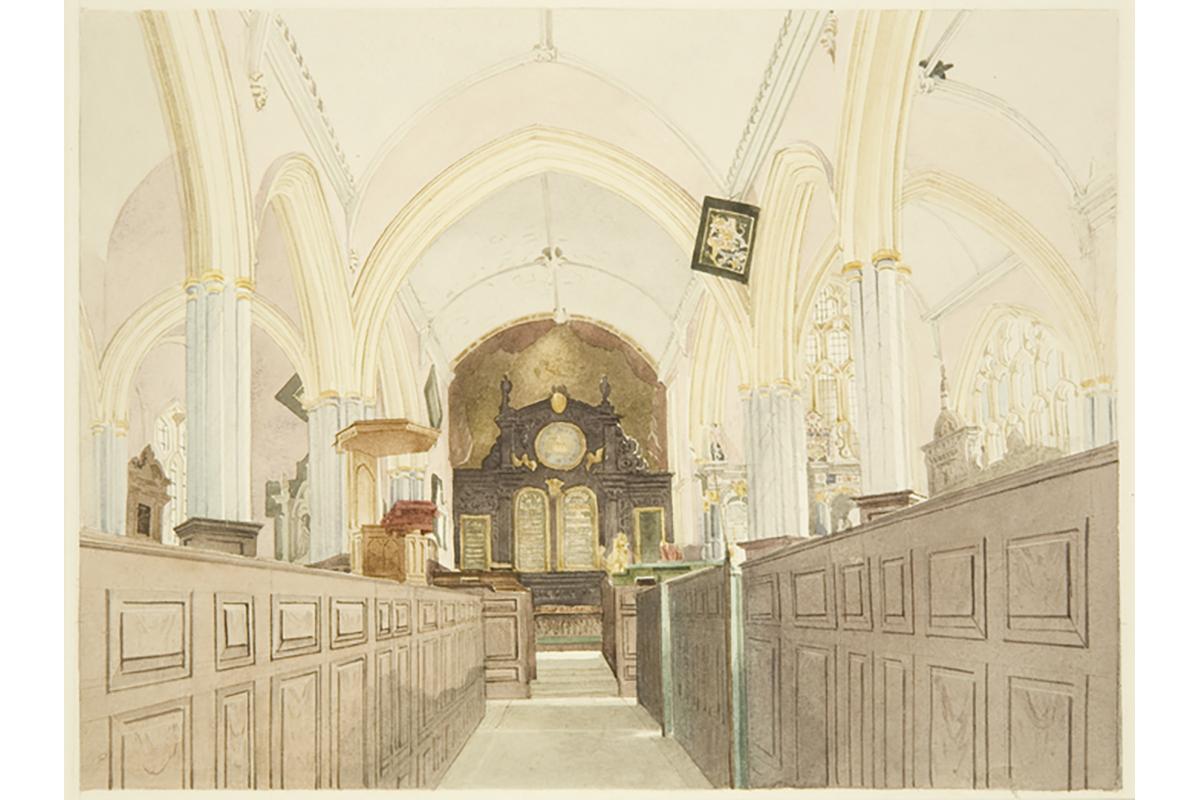
Above: Nave and chancel of St Peter's, by J. Johnson, 1828, Reproduced with permission of Bristol Museum and Art Gallery (ref. M2670)
Bristol Blitz and Castle Park
Early 20th-century Bristol was a major transport hub and industrial centre, and consequently it was a prominent target for the Luftwaffe during the Second World War. On the night of the 24–25 November 1940, 5,000 incendiary and 10,000 high explosive bombs were dropped on the city centre, much of which was reduced to rubble. St Peter’s Hospital was destroyed, and St Peter’s Church was gutted, leaving the building as a roofless and windowless shell. Most of the internal fixtures were destroyed and the Aldworth and Newton memorials were badly damaged. The surviving parts of these were subsequently dismantled and moved to museums for storage. After the War, many of the city’s bomb sites were used as carparks, but St Peter’s Church was left ruinous and overgrown. During the 1970s, the post-war carparks were replaced by the landscaped gardens of Castle Park. St Peter’s was patched up, large concrete supports were built to strengthen its crumbling walls, and an ornamental garden was laid out in the churchyard.
Time has subsequently taken its toll on the building, but Bristol City Council’s recent repairs have saved St Peter’s from further deterioration, and it is hoped that the current archaeological work will play its part in bringing the building back into public use.
Below: Interior of St Peter’s looking west
